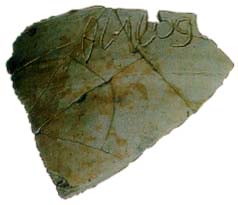Image Details

Courtesy Avraham Biran and Hebrew Union College-Jewish Institute of Religion
Unusually large Phoenician script, deeply incised before firing of the original vessel, forms the inscription on the potsherd at right. The inscription reads, “belonging to Baalpelet” (lbÔlplt ). The name means “may Baal rescue,” referring to the pagan god Baal, so it may not belong to an Israelite. Excavated from a seventh-century B.C.E. building in 1968, the ostracon measures about 10 inches wide and 9 inches high.
Another ostracon with the letters l and
